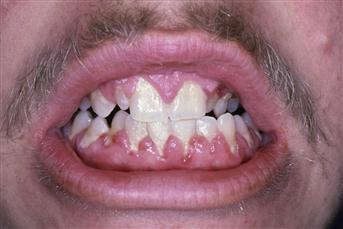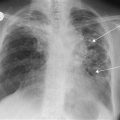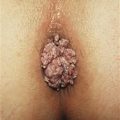Gum Disorders
Disorders of the gums are common, especially bleeding from the gums. Most disorders that cause bleeding are due to local infective disease but may be a manifestation of systemic disease.
History
Periodontal disease is probably the most common factor causing bleeding from the gums. Poor hygiene is usually obvious from the condition of the teeth. Infection will cause the patient to complain of red, inflamed gums, which bleed spontaneously or on brushing the teeth. Patients may have a history of recent malignancy for which they have undergone either chemotherapy, with associated blood dyscrasia, or local radiotherapy. There may be a history of painful lesions in the mouth to suggest herpes simplex. Rarely, infectious mononucleosis may cause gingivostomatitis. The patient may present with a pyrexial illness with malaise, lethargy and lymphadenopathy. Abnormalities of the bone marrow, e.g. malignant infiltration or aplastic anaemia will result in agranulocytosis and thrombocytopenia. Agranulocytosis causes reduced resistance to infection; thrombocytopenia is associated with a bleeding tendency. There may be a generalised illness with malaise and lethargy associated with lymphadenopathy, bruising and spontaneous bleeding from other orifices. There may be a history of haemophilia or von Willebrand’s disease. Rarer conditions include scurvy (subclinical vitamin C deficiency may occur in the elderly) and hereditary haemorrhagic telangiectasia. Check for a family history of bleeding disorders. A full drug history should be taken. Check whether the patient is on phenytoin, nifedipine or ciclosporin. Check for occupational exposure to chemicals, especially arsenic and lead.
Examination
Local
Inspect the gums for signs of inflammation and bleeding. Is it only the gums that are involved or does the condition affect the whole of the oral cavity? Check the condition of the teeth, looking for dental caries or periodontal disease. Is there any evidence of gingival hyperplasia? In gingival hyperplasia, the gum hypertrophy predominantly involves the interdental papillae. Is there any localised ulceration of the gum to suggest neoplasia? Is there any evidence of gum retraction? This occurs commonly in ageing but may be associated with chronic periodontal disease. Arsenic and lead are rare causes of gingival bleeding. The gingiva become inflamed, swollen and bleed easily, and, in the case of lead, there is a characteristic blue line at the gingival margin. Other signs of lead poisoning may be present, particularly pigmentation of the skin, vomiting, diarrhoea and hyperkeratosis of the soles of the feet and the palms of the hands. Peripheral neuropathy may be present with arsenic poisoning.
General
Conduct a general examination of the patient. Is there any evidence of systemic disease? Check for lymphadenopathy, hepatosplenomegaly and generalised bruising. Check for telangiectasia.





